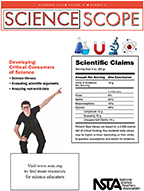Developing critical consumers of science
By Mary Bigelow
Posted on 2013-11-22
 Each month, the NSTA journals have many ideas for helping students become producers of knowledge, through science investigations and engineering problems. This issue, however, looks at how students can become informed consumers of science and engineering. As the editor notes, “To be critical consumers…students need more than just exposure to core science content; they also need to locate, read, and understand information and to use their knowledge about the nature of science to judge the validity and quality of that information and how it was gathered or constructed.” Regardless of the grade level you teach, you can find articles here with suggestions to enhance student skills in information location, evaluation, interpretation, and use.
Each month, the NSTA journals have many ideas for helping students become producers of knowledge, through science investigations and engineering problems. This issue, however, looks at how students can become informed consumers of science and engineering. As the editor notes, “To be critical consumers…students need more than just exposure to core science content; they also need to locate, read, and understand information and to use their knowledge about the nature of science to judge the validity and quality of that information and how it was gathered or constructed.” Regardless of the grade level you teach, you can find articles here with suggestions to enhance student skills in information location, evaluation, interpretation, and use.
“Where will you get your information about new science after you take your last science class?” is a question asked by the author of Building Science Literacy by Reading Science News. He describes an ongoing project in which students look at science news: what’s reported, how it’s reported, and the source. After modeling how to “dissect” a news story (with guiding questions), the students spend one day a month on science news presentations. The guidelines are included with the article.
The NGSS documents include a cross-walk between science and literacy standards. Saturn, Science, and Cross-Curricular Literacy Standards shows “how the questions students ask during science lessons can be thoughtfully integrated with strategies for literacy instruction and science practices such as engaging in argument from evidence and the crosscutting concept of patterns. The authors describe an organizer called a “comprehension window,” using a file folder and sticky notes for claims. The graphics in the article illustrate how this was used to investigate the temperatures on planets. [SciLinks: Planets, Solar System]
Part of understanding science information is becoming familiar with the vocabulary—the technical vocabulary as well as words that have different meanings in science contexts (such as theory or energy). Increasing Science Vocabulary Using PowerPoint Flash Cards shows two strategies: a mnemonic keyword strategy and using PowerPoint to create “flash cards.” Technology also plays a role in the study described in Human Impact on Water Quality: Conducting Inquiry with Cyber Databases and ICTs (information and communications technologies). The authors share credible online sources of real-world data and ideas for how students can use this wealth of data to create information. [SciLinks: Water Quality]
Sometimes we need to make quick decisions and other times we need more reflective and purposeful thought. Evaluating Scientific Arguments with Slow Thinking describes these two forms of systems thinking and has examples of the shortcomings of “fast” thinking and suggestions for promoting more in-depth thinking and argumentation with a claim-evidence-reasoning framework.
One of my favorite resources is the Natural Inquirer (a free research journal written in student-friendly language). The author of Engaging Middle School Students in the Analysis and Interpretation of Real-World Data describes how she guides students through reading and analyzing an article on how much time kids spend outdoors. The main focus here was on interpreting the data represented by the graphs. The students then replicated the study using their own survey data and compared the results to the published study.
We teachers want to help students learn. But sometimes the best way is not to give students a correct answer but to provide ways they can use a variety of sources to evaluate their response. Student-to-Student Collaboration and Coming to Consensus has two examples of what this looks like in a middle school classroom. The teacher provides a focus for reading and a prompt for student responses. Pairs of students shared their responses and then read information on the topic. They then discuss their responses in the context of the reading and try to reach a consensus. The second example is a Think-Ink-Pair-Share activity. Most of us have used TPS, but this variation has students write a response before refining it through pairing and sharing. When the teacher demonstrates the concept, the students evaluate their responses. [SciLinks: The Moon, Rotational Motion]
When reading research from the fields of medicine or psychology, it’s important to consider just who the subjects are. Classroom Zoo* has suggestions for helping students learn how to conduct research with live specimens in an ethical and responsible manner. The author includes a timeline and student handouts for a research project.
When assigning videos in the classroom or online, teachers should also be aware of Safety in Videos. Ken Roy has suggestions on what to consider when creating or choosing online media.
* Many of these articles have resources to share, so check out the Connections for this issue (November 2013). Even if the article does not quite fit with your lesson agenda, there are ideas for handouts, background information sheets, data sheets, rubrics, and other resources.
Disclaimer: The views expressed in this blog post are those of the author(s) and do not necessarily reflect the official position of the National Science Teaching Association (NSTA).

